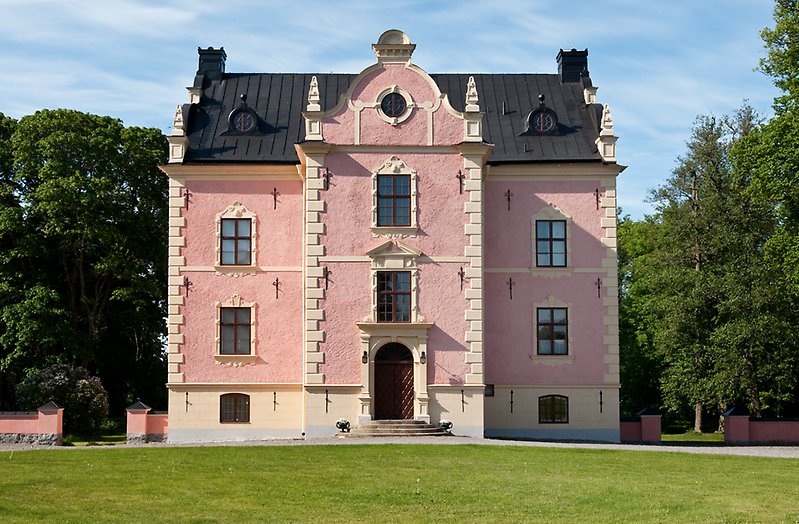
Upplands väsby, Uppland
Skånelaholm Castle
Skånelaholm Castle was built in c.1639–1643 by Sweden’s top judge, Andreas Gyldenklou, in the German–Dutch Renaissance style, but the property had been first mentioned in a charter of 1276, when King Magnus III sold it to the Cistercian nunnery at Skokloster. The castle has not changed hands often, and between 1742 and 1918 was owned by the Jennings, a mill-owning family. In the 1890s, the original brick facades were stuccoed and the windows given highly ornamental surrounds. Today, the castle and its wings have been returned to their 1890s colours
Herbert Rettig bought the castle in 1929. He was the last private owner. In 1962, he and his wife Ing-Marie Rettig donated the Skånelaholm to Vitterhetsakademien for it to be ‘preserved in good condition as a cultural monument’.
Today, Skånelaholm houses furniture, art, books, and a large collection of Swedish folk art collected by the Rettig family, who were interested in local heritage. Among the attractions are an eighteenth-century pharmacology cabinet and a collection of nineteenth-century coaches and carriages.
There had probably once been a garden, but a map from the 1680s only shows meadows, fields, and a hop garden. In the mid eighteenth century, a magnificent formal garden was laid out, and in the early nineteenth century it was transformed into an English landscape garden, with walking paths and avenues. Parts of the avenues still survive. North of the house in the park is the Sälna rune stone. Originally at least three metres high, it stood by Sälna Bridge on the route between Skånela and Vallentuna. The countryside around Skånelaholm has one of the highest concentrations of rune stones in Sweden, a clear sign there was once a Viking Age waterway here.
Skånela Folk Museum dates from 1935.
The museum’s collection includes much of the folk art assembled by the castle’s earlier owner, Herbert Rettig. He was also responsible for rescuing the old courthouse and prison from nearby Seminghundra and the post mill from across the fields in Hargsbro and rebuilding them at the museum.
Information
Skånelaholm Castle is open May to September. Re-opening in May 2024. Welcome!
The castle is open for guided tours, Wednesday to Sunday, May to September (closed Midsummer Eve and Midsummer Day)
The castle is open all year for groups by arrangement.
Themed guided tours:
Andreas Gyldenklou, a self-made man: From Slomarp Farm to diplomat (in Swedish)
The Sälna rune stone (in Swedish)
Highlights of Skånelaholm Castle collections (in Swedish)
The Jennings family, eighteenth-century immigrants (in Swedish)
The Rettig family at Skånelaholm (in Swedish)
Women of Skånelaholm (in Swedish)
To book a group tour or a themed guided tour, contact Irina Romanenko, irina.romanenko@vitterhetsakademien.se, +46 (0)70–664 14 75.
gift shop
The gift shop sells souvenirs, gifts, replicas, and books inspired by Skånelaholm Castle and its collections. Gift shop are open 11.00–16.00 Wednesday to Sunday, May to September (closed Midsummer Eve and Midsummer Day).
Bilder
The Royal Swedish Academy of Letters, History and Antiquities
Phone: +46 8-440 42 80
Bank: 535-3552
E-mail:
kansli@vitterhetsakademien.se
Postal address:
Kungl. Vitterhetsakademien
Box 5622
114 86 Stockholm
Visiting address:
Villagatan 3, Stockholm
© THE ROYAL SWEDISH ACADEMY OF LETTERS, HISTORY AND ANTIQUITIES

